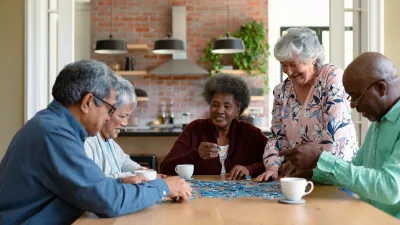London-based Transport for All bemoans the inaccessibility of our urban environs for older residents. In this article, they ask designer Neil Chambers how he would design a city to 'facilitate an active and flexible lifestyle for the elderly.'
"The current conversation about redesigning cities usually focuses on Boomers or Millennials, two extremes of the age spectrum. However, the largest proportion of people are between 30 and 64 years old. Everyone will eventually be elderly, a reality no one can escape," says Chambers. "The best cities in the world like New York, Berlin, and Tokyo market themselves as meccas for young, energetic people that promise diversity and innovation. This generates a lack of ideal architecture for people over the age of 65 and shuts the door on them, depriving us of the knowledge, stability, and experience they provide to our civilization."
To test out some ideas for how to better integrate the elderly in urban life, Chambers and his team proposed a project for Brooklyn's DUMBO neighborhood that "embraced young and old with buildings that commission graffiti, have ramps for golf carts, and provide a mix for all ages."
FULL STORY: What can we do to make cities less lonely for the elderly?

Maui's Vacation Rental Debate Turns Ugly
Verbal attacks, misinformation campaigns and fistfights plague a high-stakes debate to convert thousands of vacation rentals into long-term housing.

Planetizen Federal Action Tracker
A weekly monitor of how Trump’s orders and actions are impacting planners and planning in America.

San Francisco Suspends Traffic Calming Amidst Record Deaths
Citing “a challenging fiscal landscape,” the city will cease the program on the heels of 42 traffic deaths, including 24 pedestrians.

Defunct Pittsburgh Power Plant to Become Residential Tower
A decommissioned steam heat plant will be redeveloped into almost 100 affordable housing units.

Trump Prompts Restructuring of Transportation Research Board in “Unprecedented Overreach”
The TRB has eliminated more than half of its committees including those focused on climate, equity, and cities.

Amtrak Rolls Out New Orleans to Alabama “Mardi Gras” Train
The new service will operate morning and evening departures between Mobile and New Orleans.
Urban Design for Planners 1: Software Tools
This six-course series explores essential urban design concepts using open source software and equips planners with the tools they need to participate fully in the urban design process.
Planning for Universal Design
Learn the tools for implementing Universal Design in planning regulations.
Heyer Gruel & Associates PA
JM Goldson LLC
Custer County Colorado
City of Camden Redevelopment Agency
City of Astoria
Transportation Research & Education Center (TREC) at Portland State University
Jefferson Parish Government
Camden Redevelopment Agency
City of Claremont





























